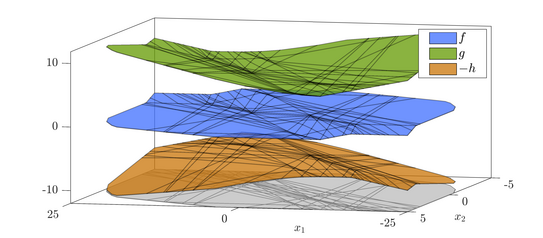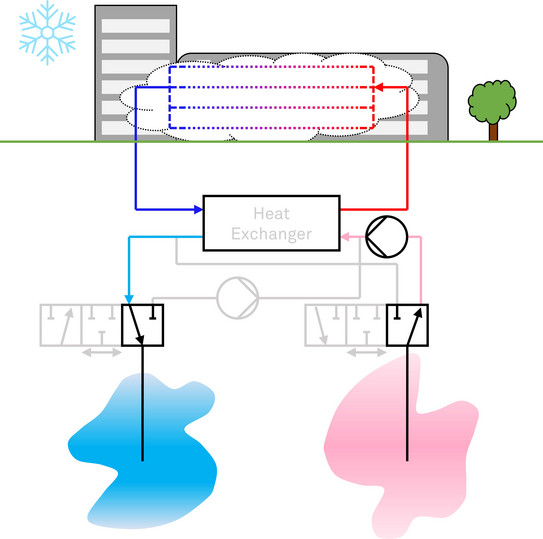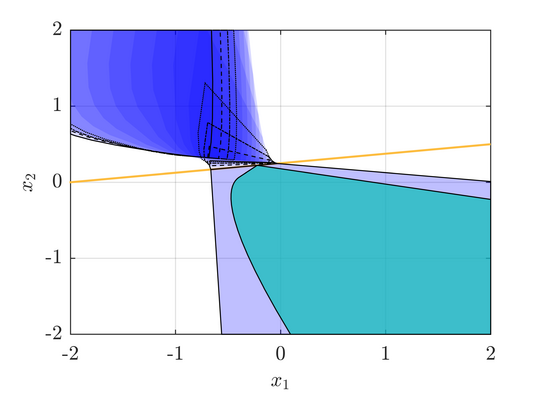Goals and Directions
Control systems are getting more and more complex and solving control tasks increasingly relies on interdisciplinary approaches combining elements from mechatronics and cybernetics. Against this background, we aim for tailored control schemes that address the special needs of such cyberphysical systems. In particular, we design networked and autonomous control systems involving numerical optimization, machine learning, and cybersecurity.
Secure control for networked systems
Cloud-computing and distributed computing are becoming ubiquitous in modern control systems such as smart grids, building automation, robot swarms, or intelligent transportation systems. While cloud-based and distributed control schemes offer many opportunities, they also increase the risk of cyberattacks. In fact, the involved communication and evaluation of sensitive data via public networks and on thirdparty platforms promote eavesdropping and manipulation of data. Future control schemes should counteract those threats and ensure confidentiality and integrity of the involved data. We address these needs with tailored control schemes that combine methods from cryptography, numerical optimization, and control.
Related projects
Resilience meets secure networked control (Rescuenet)
Applied encrypted control for critical infrastructure (Aperitif)
Encrypted optimization-based control for networked systems (EpicNets)


Explainability in Data-Driven Control
Data-driven predictive control (DPC) is a method that uses collected trajectory data to make predictions, offering an alternative to traditional model predictive control (MPC). Instead of relying on an explicit system model, DPC uses linear combinations of recorded data to predict future system behavior.
However, the absence of an explicit prediction model can make it difficult to understand the effects of commonly used regularization terms and the resulting predictions. This lack of transparency can lead to challenges, such as the need for empirical tuning of regularization parameters and potentially misleading interpretations of norm-based regularizations. Our research aims to address these issues by analyzing the structure of the underlying optimal control problem in DPC, enhancing the explainability and reliability of DPC.
Related publications
M. Klädtke and M. Schulze Darup, Implicit predictors in regularized data-driven predictive control, IEEE Control Systems Letters, vol. 7, pp. 2479-2484, 2023. DOI: 10.1007/LCSYS.2023.3285104, Preprint: arXiv:2307.10750
M. Klädtke and M. Schulze Darup, Towards explainable data-driven predictive control with regularizations, at - Automatisierungstechnik, 2025. Accepted January 17, 2025. Preprint: arXiv:2503.21952

Tailored learning-based control
Learning-based predictive control is gaining popularity, but typical challenges include neural network-based approximation of the control law or optimal value functions. Often, the underlying optimal control problems exhibit special structure. We leverage this by designing tailored neural networks (NNs) for learning-based control.
We utilize specialized NN topologies, such as maxout NNs, to exactly represent piecewise quadratic (PWQ) functions. These functions naturally appear in linear model predictive control (MPC) as optimal value functions and Q-functions. This approach exploits the inherent structure of control problems, leading to efficient and accurate approximations.
Our research also focuses on the rigorous analysis of NN-based controllers. We use mixed-integer programming (MIP) to analyze the closed-loop behavior of systems controlled by NN-based controllers. This methodology allows us to certify stability and ensure constraint satisfaction, which is crucial for the reliable deployment of these controllers in safety-critical applications.
Related publications
D. Teichrib and M. Schulze Darup, Reachability analysis for piecewise affine systems with neural network-based controllers, Proc. of the 63rd IEEE Conference on Decision and Control (CDC), pp. 894-900, 2024. DOI: 10.1109/CDC56724.2024.10886414, Preprint: arXiv:2411.03834
D. Teichrib and M. Schulze Darup, Error bounds for maxout neural network approximations of model predictive control, IFAC-PapersOnLine, 56(2): pp. 10113-10119, 2023. DOI: 10.1016/j.ifacol.2023.10.883. Preprint: arXiv:2304.08779.
D. Teichrib and M. Schulze Darup, Tailored max-out networks for learning convex PWQ functions, in Proc. of the 2022 European Control Conference (ECC), pp. 2272-2278, 2022. DOI: 10.23919/ECC55457.2022.9838225, Preprint: arXiv.2206.06826
N. Schlüter and M. Schulze Darup, Novel convex decomposition of piecewise affine functions, in Proc. of the IFAC World Congress, 2020.
M. Schulze Darup, Exact representation of piecewise affine functions via neural networks, in Proc. of the 2020 European Control Conference (ECC), pp. 1073-1078, 2020. DOI: 10.23919/ECC51009.2020.9143957

Predictive control for geothermal systems
We pioneer advanced control and estimation techniques for complex cyber-physical systems with an emphasis on improving sustainability and efficiency of geothermal systems. For instance, our recent work on aquifer thermal energy storages (ATES) leverages sophisticated model predictive control with mixed-integer programming to achieve sustainable and economically viable operations. Furthermore, we design robust and computationally efficient state estimators to accurately determine critical states in hybrid systems where direct measurements are scarce. These developments showcase our dedication to advancing optimization-based control and hybrid systems analysis for impactful real-world solutions. Moving forward, we will apply and expand these powerful techniques to address emerging challenges in smart grids, autonomous robotics, and sustainable manufacturing, while also harnessing the potential of artificial intelligence to create more adaptive and intelligent systems. Our ultimate aim is to continuously advance the theory and practice of control systems for a more efficient and resilient future.
Related publications
J. van Randenborgh and M. Schulze Darup, MPC using mixed-integer programming for aquifer thermal energy storages, Proc. of the 8th IFAC Conference on Nonlinear Model Predictive Control (NMPC), vol. 58(18), 2024. DOI: doi.org/10.1016/j.ifacol.2024.09.004

New approaches to model predictive control
Model predictive control (MPC) is one of the most powerful, widely-used, and well-studied control schemes. Its underlying idea can be traced back to the 60s. Since then, countless successful applications and theoretical improvements have been reported. Nevertheless, the theory for MPC is far from complete and novel variants and implementations pop up regurlarly. We contribute structural insights on linear and nonlinear MPC, fast real-time implementations, and secure controller evaluations.
Related publications
M. Schulze Darup, M. Klädtke, and M. Mönnigmann. Exact solution to a special class of nonlinear MPC problems, in Proc. of the 7th IFAC Conference on Nonlinear Model Predictive Control (NMPC), pp. 294-299, 2021. DOI: 10.1016/j.ifacol.2021.08.559.
M. Schulze Darup, G. Book, and P. Giselsson, Towards real-time ADMM for linear MPC, in Proc. of the 2019 European Control Conference, pp. 4276-4282, 2019. DOI: 10.23919/ECC.2019.8796239
M. Schulze Darup and M. Cannon, Some observations on the activity of terminal constraints in linear MPC, in Proc. of the 2016 European Control Conference, pp. 770-775, 2016. DOI: 10.1109/ECC.2016.7810382









